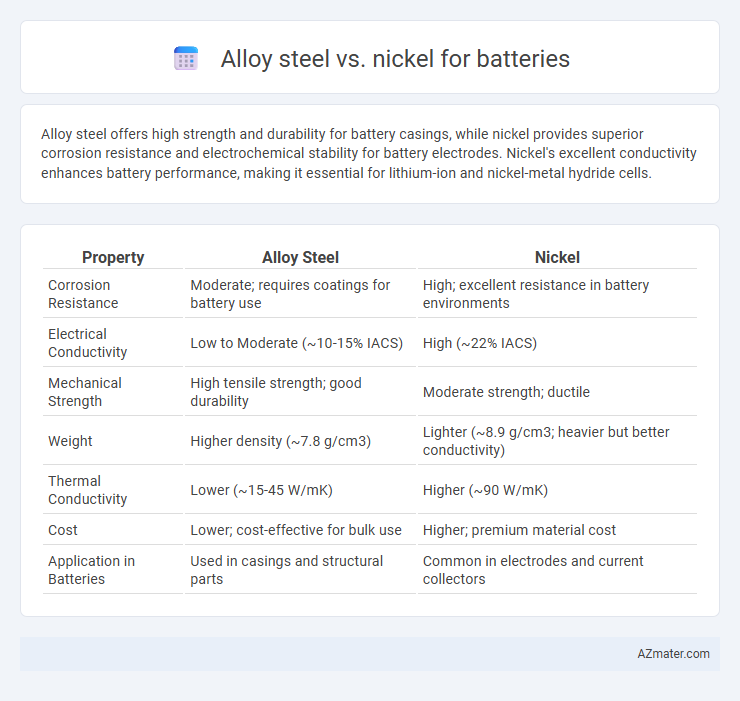Alloy steel offers high strength and durability for battery casings, while nickel provides superior corrosion resistance and electrochemical stability for battery electrodes. Nickel's excellent conductivity enhances battery performance, making it essential for lithium-ion and nickel-metal hydride cells.
Table of Comparison
| Property | Alloy Steel | Nickel |
|---|---|---|
| Corrosion Resistance | Moderate; requires coatings for battery use | High; excellent resistance in battery environments |
| Electrical Conductivity | Low to Moderate (~10-15% IACS) | High (~22% IACS) |
| Mechanical Strength | High tensile strength; good durability | Moderate strength; ductile |
| Weight | Higher density (~7.8 g/cm3) | Lighter (~8.9 g/cm3; heavier but better conductivity) |
| Thermal Conductivity | Lower (~15-45 W/mK) | Higher (~90 W/mK) |
| Cost | Lower; cost-effective for bulk use | Higher; premium material cost |
| Application in Batteries | Used in casings and structural parts | Common in electrodes and current collectors |
Introduction to Alloy Steel and Nickel in Battery Technology
Alloy steel, characterized by its enhanced strength and corrosion resistance, is increasingly utilized in battery casings and structural components to improve durability and safety. Nickel, a key material in battery cathodes, significantly boosts energy density and lifespan in lithium-ion batteries due to its excellent electrochemical properties. Combining alloy steel's mechanical robustness with nickel's electrochemical efficiency supports advanced battery designs for electric vehicles and energy storage systems.
Chemical Composition and Material Properties
Alloy steel used in battery applications typically contains elements like chromium, manganese, and carbon, enhancing strength, corrosion resistance, and durability compared to pure metals. Nickel offers excellent chemical stability and high corrosion resistance, making it ideal for battery electrodes where electrochemical performance and longevity are critical. The chemical composition of alloy steel results in higher tensile strength and wear resistance, while nickel provides superior conductivity and resistance to oxidation, influencing battery efficiency and lifespan.
Conductivity: Electrical and Thermal Comparisons
Alloy steel exhibits lower electrical conductivity compared to nickel, making nickel the preferred choice for battery applications requiring efficient electron flow. Nickel also surpasses alloy steel in thermal conductivity, enabling better heat dissipation during battery operation. These conductivity advantages contribute to nickel's dominance in high-performance battery electrodes and current collectors.
Corrosion Resistance in Battery Environments
Alloy steel exhibits moderate corrosion resistance in battery environments but may require protective coatings to prevent degradation from acidic electrolytes. Nickel offers superior corrosion resistance due to its stable oxide layer, making it highly effective in alkaline and acidic battery conditions. The enhanced durability of nickel prolongs battery component life, reducing maintenance and improving overall performance.
Mechanical Strength and Durability
Alloy steel offers superior mechanical strength compared to nickel, making it highly resistant to deformation and wear in battery applications. Nickel provides excellent corrosion resistance but has lower tensile strength than alloy steel, impacting long-term durability under mechanical stress. Combining alloy steel's toughness with nickel's corrosion resistance can optimize battery longevity and structural integrity.
Cost Analysis: Alloy Steel vs Nickel
Alloy steel generally offers a more cost-effective solution compared to nickel for battery components due to its lower raw material and manufacturing expenses. Nickel prices tend to be higher and more volatile, impacting the overall cost efficiency of nickel-based batteries. When evaluating battery material costs, alloy steel provides a more stable and economical option, especially for large-scale production.
Performance Impact on Battery Efficiency
Alloy steel enhances battery structural integrity and heat resistance, improving overall battery performance under high stress conditions, while Nickel significantly boosts energy density and cycle life by facilitating efficient electrochemical reactions. Nickel's high conductivity and capacity contribute to faster charge times and extended battery runtime, whereas alloy steel primarily supports durability and safety. The combination of nickel and alloy steel materials in batteries optimizes both energy storage efficiency and mechanical stability, directly impacting battery longevity and operational effectiveness.
Environmental Sustainability and Recycling
Alloy steel and nickel play distinct roles in battery production, with nickel offering higher energy density but posing greater environmental challenges due to intensive mining and complex recycling processes. Alloy steel, commonly used in battery casings, is more easily recyclable and has a lower environmental footprint during production and end-of-life stages. Prioritizing the use of recyclable alloy steel components and improving nickel recycling technologies can significantly enhance the sustainability of battery manufacturing and reduce ecological impacts.
Applications in Modern Battery Designs
Alloy steel in modern battery designs primarily serves as a durable casing material enhancing structural integrity and heat resistance, crucial for lithium-ion battery packs in electric vehicles and energy storage systems. Nickel, often used as a key cathode component or plating material, significantly improves battery energy density, corrosion resistance, and charge-discharge efficiency. Applications highlight alloy steel's mechanical robustness and nickel's electrochemical performance, optimizing battery lifespan and safety in consumer electronics, automotive, and renewable energy sectors.
Future Trends in Battery Material Innovation
Alloy steel and nickel play crucial roles in battery technology, with nickel increasingly favored for its high energy density and cost-effectiveness in lithium-ion batteries. Future trends indicate a shift towards nickel-rich cathodes, enhancing battery performance while alloy steel components continue to provide mechanical strength and durability in battery casings. Advances in material innovation focus on optimizing nickel content to balance capacity, safety, and lifespan, driving next-generation energy storage solutions.

Infographic: Alloy steel vs Nickel for Battery
 azmater.com
azmater.com